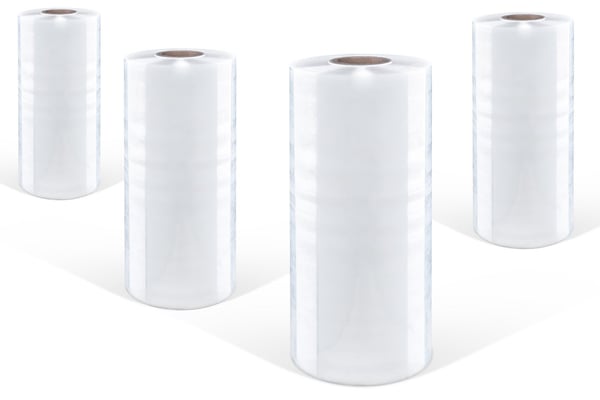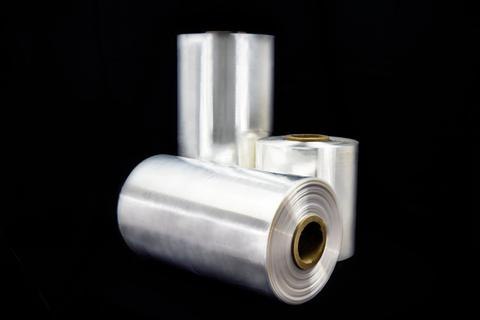Top 5 Quality Issues With Shrink Film
Packaging Materials | Technical Service and Support | Plant Performance
If you are running shrink film on your packaging line, chances are you have run into performance issues at some point or another. Dog ears, poor seals and other annoyances can pop up based on various factors. Here at Industrial Packaging, we have been selling and working with shrink film for almost 70 years. During that time, we have run into every potential issue that the material has to offer. In this article, we will discuss the top 5 quality issues with shrink film and provide advice on how to avoid or negate them.
Clarity Of Shrink Film
When it comes to using shrink film to package your products, clarity is key. While shrink film is used to unitize products and offers protection to the contents inside, the clarity of the film is particularly important. A quality clear shrink film allows consumers to see your product and gives a beautiful gloss to items contained within. This is one reason that many toy manufacturers use shrink film to package toys and board games.
The clarity of your shrink film can be compromised due to various factors including improper storage and/or storing for an excess of time over the expiration date. Generally speaking, the expiration date for most films unless otherwise specified is one year from the date of arrival to your location.
After this length of time, continued storage rather than utilization will eventually result in a yellowing of the film. This results in less shelf appeal and may be a turnoff to consumers. Additionally, storing shrink film in extreme cold can result in cracking.

Wrinkles On Shrink Film
After shrink film is extruded, it is rewound at a high speed. Sometimes the film becomes wrinkled during this process. Although this does not typically create a problem with appearance, as the shrinking process typically pulls out the wrinkles, wrinkles can create problems with the tracking of the film on high speed applications.
In printed shrink film applications, wrinkles can be a major problem if the printer cannot remove the wrinkles prior to the actual printing. If the film is printed with the wrinkles in it, the shrinking process will remove the wrinkles and the result will be a print void, in which there is no ink.
Are You Using The Right Shrink Film?
Uneven Edges On Rolls Of Shrink Film
When running rolls of shrink film on your machinery, problems with uneven rolls can occur. This is particularly true when using lap sealers. When a shrink film vendor produces a roll of film, sometimes there are issues with winding it perfectly straight. This causes the edges of each layer not to line up which can make the film come out of the lap seal.
Unfortunately, there is no fix for an uneven roll of shrink film. In order to remedy this situation you will need to send it back to the supplier and ask for a refund or replacement roll. To avoid this, you will want to be sure that you are buying from a trusted vendor, ideally a local one. If you do not source your materials from a local company, you will want to be 100% sure that the company has excellent customer service and turnaround time for returns.
When sourcing shrink film for your machinery, it would be wise not to buy the cheapest rolls you can find from the first vendor you discover. Before choosing a materials vendor, you should deeply research 3 or 4 vendors you feel will provide you with excellent customer service, materials, response time to orders, returns and refunds when necessary. Failure to do this may result in downtime, wasted dollars and man-hours.

Blocking On Shrink Film
If the layers of your shrink film are sticking to each other, this may mean that your film is suffering from what is commonly known in the industry as “blocking.” This usually happens when the film is being stored in excessively high heat. When this happens, the separate layers of shrink film on the roll will melt together. In order to avoid blocking on your film, you will need to store the material at the recommended temperature. This is dependent on the type of film; ask your vendor if not listed on the roll itself.
Poor Seals Due To Film Chemistry
There are various chemical formulations for shrink film, the most common being POF (Polyolefin), PVC (Poly Vinyl Chloride) and PE (Polyethylene). The formulations of these films are all unique and result in different applications for each type of film.
If the chemical formulation is not perfect, it can result in poor quality films. When the formulations are not correct, the films will not seal and may produce other issues including, smoking, melting and in some cases mechanical failure.
This is another situation that cannot be fixed or remedied. You will need to get a refund or replacement from your vendor. Once again, we must stress the importance of choosing a vendor with fantastic customer service, short turn around times and accessibility to speaking with a real human being rather than an automated robotic voice. This will help you get replacement film much more quickly.
Regardless of location, these dynamics are paramount when dealing with the common issues that can arise from running shrink film. When a problem occurs, you do not want to have to jump through hoops to get a solution to the problem.
Other Common Problems With Shrink Film
Package appearance problems
Package appearance problems are another set of issues with shrink film. These are typically instances of poor shrink, crow’s feet, dog ears or fish-eyes. To avoid these issues, make sure your seals are good and not weak or blown out. If blown out, they let too much air escape too quickly and this causes the film not to shrink all the way.
Perforations are also the culprit when it comes to crows feet and fish-eyes. Sometimes too many perforations on your film will affect the package appearance.
Dog ears are typically a result of too much film or incorrect tunnel settings. If your conveyor speed is set too fast, the package doesn’t have enough time in the tunnel to shrink all the way. Dog ears could be the result of improper air evacuation where the air escapement hole is blocked too soon and doesn’t let the air out. Look at your film selection and try a lighter gauge or different formulation if these other remedies fail.
Holes in the top of the package
Holes in the top of the package are typically due to either incorrect tunnel settings or incorrect set up of pin perforations. The tunnel may be too hot or the t-conveyor set too slow. Or, your pin perforations are set too deep and tearing the film instead of perforating. The pins could also be dull and not puncturing the film, causing weak spots.
Re-wraps
Re-wraps can be caused by several potential issues but most instances are related to equipment settings and maintenance. If you are not sure how to set your equipment to negate this issue, you should contact a packaging machinery service technician for assistance.
Static
If your film is not opening, it is likely due to static cling. You will need to remove the static in the film. There are a couple of ways to accomplish this. The first is to lay the roll of film flat on a concrete floor overnight and see if the static dissipates. The other option requires adding some device to your wrapper to pull static off the roll such as a metal tinsel strip or an air ionizer. In the latter case, you will want to contact a local packaging professional to get a quote on this machinery.
Dropped edges
In the extrusion and rewinding process, if tension settings are not appropriate, the film can “droop” on one side of the roll. When running on high speed equipment this can create problems. If you run into this problem, which is typically evidenced by inability to properly track the film, flip the roll over and move the dropped edge side to the opposite side.
This often corrects the problem. If it does not, or if the problem continues with many rolls of film contact your supplier. An experienced distributor will be able to guide you to a resolution, whether it be machine adjustments or more appropriate specifications for you film.
Gauge bands
Shrink film, which is thinner than a human hair, and available in lighter and lighter gauges as technology improves, has an “average yield” based on the fact that the actual thickness of the film varies throughout the roll. If you are buying 45 gauge film, and you measure it with a micrometer, you may find one spot at 42 gauge and another at 48.
This should not be a problem. If, however, there is a manufacturing defect in the extrusion of the film, it is possible to see narrow bands within the roll where the gauge is significantly out of specification. This will result in the inability to seal the film or shrink it properly. This film should be set aside and replaced by the supplier.
How To Avoid Common Quality Issues With Shrink Film
Armed with the information above, you should be equipped to avoid these shrink film problems. That being said, it is good to have a packaging heavyweight in your corner.
One of the best ways to fix these shrink film issues is to avoid them altogether. This is can be done by implementing a preventative maintenance program and a quarterly analysis of your packaging line.
A preventative maintenance program will ensure that there are regular inspections of your machinery and materials. Developing a quarterly analysis of your packaging processes, materials, and protocols will allow you to eliminate many problems before they occur.
You can easily set up an analysis of your packaging line with Industrial Packaging. Regular analysis of your packaging line will help to ensure that you are running in line with top key performance indicators which will help to reduce downtime and common problems associated with materials like shrink film.
About Nathan Dube
As the Digital Marketing Specialist at Industrial Packaging, I am honored to create content for such a phenomenal company and work with one of the greatest teams in the Packaging Industry. Whether creating a video, writing blog posts or generating other pieces of content and multimedia, I am always excited to help educate and inspire our prospects and clients to reach their highest potential in regards to their packaging processes and needs.




